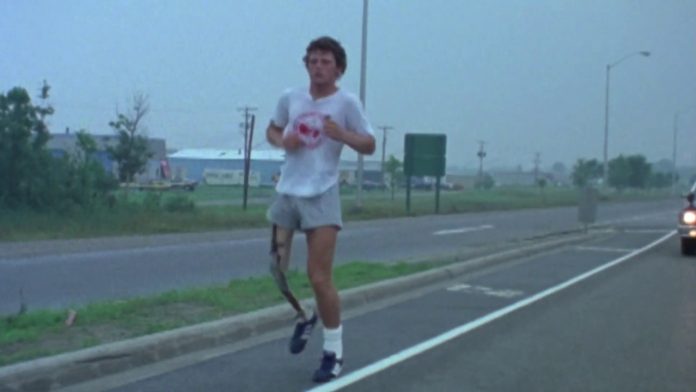It was 40 years ago this week that Canadian Terry Fox became a running icon; one honored beyond all other runners for a courageous performance; one that arguably surpasses the gold medals and world records of any runner before him or since. Terry Fox simply started running, putting one foot in front of the other. It was one of running’s greatest days.
Growing up in British Columbia, Terry wanted to play basketball, but his height was a barrier to making the varsity team. He ran cross country to please his coach. It was not his first choice, but it is for his running that he will be forever remembered.
In November 1976, at age 18, Terry was involved in a car accident. Although his only injury was a sore right knee, the pain never seemed to subside. Four months later, Terry finally went to the hospital. The diagnosis, however, was far from what he expected.
Terry was told he had a rare form of cancer; that his right leg had to be amputated; that he would require extensive chemotherapy; and that there was only a 50 percent chance he would survive.
The night before his surgery to remove his leg, Terry read an article about the first amputee to complete the New York City Marathon. The article inspired him. Six months later he told his family he planned to compete in a marathon himself.
In private, he had another plan, one far more ambitious than a 26-mile, 385-yard marathon. He was going to run across the entire expanse of Canada, a distance of more than 5,000 miles (8,000 km). Close to twice the distance from New York City to Los Angeles.
It would require 16 months of chemotherapy and many months more to regain strength before Terry was ready to test his artificial leg—not around the hospital, but on the road. More months passed putting in the daily training to be able to run a marathon, day after day, on his run across Canada. He named his run the Marathon of Hope. He wanted to raise money for cancer research.
At first, Terry would run in the anonymity of darkness. He would return home in pain, his stump bloody. But he kept going. Terry trained for 15 months, running more than 3,000 miles; running, in one stretch, every day for 101 days—until he was confident, until he could run 23 miles and come back and do it again the next day.
On April 12, 1980, Terry Fox began his run, starting from St. Johns, Newfoundland. With no great fanfare he dipped his prosthetic leg into the Atlantic Ocean, vowing he would do the same when he reached the Pacific Ocean. No one noticed.
He, and a friend who drove and cooked their meals, were alone: 5,000 miles to go.
At first, local media treated it as a curiosity, but enough so to draw local attention. Soon people were standing by the side of the road, clapping politely as Terry passed. From there, it became tens, and then hundreds, all cheering him on. He was no longer a curiosity. He was a hero. A brave young man doing the seemingly impossible.
By the time he reached Toronto on July 11, nearly three months of a marathon-a-day, Terry entered downtown to a crowd of 10,000 people lining the streets. The Cancer Society estimated it collected $100,000 in donations that day. Terry Fox was no longer running alone. He had an entire nation behind him.
The physical demands of running a marathon every day took their toll on Terry’s body. He frequently suffered shin splints and developed cysts on his stump. He suffered a soreness in his ankle that would not go away. But with each mile, Terry Fox portrayed courage. He inspired a nation. He did what no one thought possible. People lined the streets, the rural roads, the highways to see Terry; to be inspired, to cry, to cheer.
By mid-August Terry was exhausted. The enormity of his effort was taking its toll physically and emotionally. On Sept. 1, outside Thunder Bay, Ontario, he was forced to stop briefly after he suffered an intense coughing fit and experienced pains in his chest.
Unsure what to do, he resumed running as the crowds along the highway shouted out their encouragement. A few miles later, short of breath and with continued chest pain, he asked to be taken to the local hospital. Tears ran down his face. The next day, Fox held a press conference, announcing that his cancer had returned and had spread to his lungs. He was forced to end his run after 143 days and 5,373 kilometers (3,339 miles).
Terry Fox was now fighting for his life.
Nine months later, Terry died on June 28, 1981, one month short of his 23rd birthday. There was a nationwide day of mourning. Flags were lowered to half-mast.
But the Terry Fox story didn’t end with his death.
The first Terry Fox Run three months after his death inspired more than 300,000 people across Canada to walk, run and cycle in his memory, generating $3.5 million for cancer research. Today the annual Terry Fox Run involves millions of participants in more than 60 countries and is the world’s largest one-day fundraiser for cancer research raising over $750 million.
Terry Fox was the youngest ever to be awarded his nation’s highest civilian honor, the Companion of the Order of Canada. He was recognized as the nation’s top sportsman in 1980 and was named Canada’s Newsmaker of the Year in both 1980 and 1981. Considered a national hero, he has had many buildings, statues, roads, and parks across the country named in his honor.
Terry, standing at the starting line of his Marathon of Hope on April 12, 1980, hoped his run would raise $1 million for cancer research. Later, that goal became $10 million, then $1 for each of Canada’s 24 million citizens. He was not far off. Donations to his Marathon of Hope totaled $23.4 million. A mountain in British Columbia was even named after him.
April 12, 1980 is one of the greatest days in running history. It is the day a young man dipped his prosthetic leg in the Atlantic Ocean and began a solo run; a journey that few can comprehend. Terry Fox moved running from a sport to a means to measure courage, commitment and dedication. April 12, 1980 was atransformative day in running history, when running became much bigger than just putting one foot in front of the other to cover distance the fastest.
































